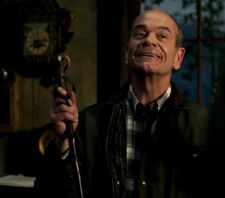| “ | Yes, fairy comes in many shapes and sizes. Magical, mischievous being from the realm next door. | ” |
Fairies, also called Ultra-Terrestrials, are mischievous supernatural creatures that come in a variety of forms. They can only be seen by those who have been to their realm or if they choose to be seen. It is revealed that they are the cause of UFO sightings and other "extraterrestrial" encounters around Earth. There are many theories about the reason they abduct people - one of them being to bring people to Avalon so they can service Oberon, King of Fairies.[1]
Characteristics
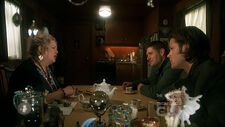
Fairies come in many forms, and have been described as "magical and mischievous beings from the realm next door". This realm, Avalon, is considered another dimension or reality. Fairies have been classified into two groups - one consisting of light fairies and the other dark ones. However, there have not been many details about identifying fairy classes.
Fairies, despite having different types, have some form of society and justice system called the Fairy Tribunal. This court decides on the fate of beings that break the presumably existing laws of their kind. This is not limited to fairies, as seen when a fairy named Gilda brought her former human enslaver to face their tribunal. Fairies, despite being different kinds, all seem to cooperate with each other.
They appear to be sensitive to "energy", as one of them made the comment that "fairies are all about energy". In Clap Your Hands If You Believe, the leprechaun that appeared was able to know that Sam Winchester had no soul, as it said that human souls have a certain "perfume".
In addition, it seems they also suffer from arithmomania, a mental disorder that may be seen as an expression of obsessive-compulsive disorder. Sufferers of this disorder have the overwhelming impulse to count their actions or objects in their surroundings. Because of this (and regardless of how powerful any fairy may be), it must stop what it is doing to count every grain of sugar or salt, one by one, if someone pours it in front of them.
Humans can interact with them and ask for favors; appeasing them by leaving a bowl of cream. Cream affects fairies in the same way that alcohol affects humans, rendering them intoxicated if they eat it. They claim to possess abilities (which they consider to be "real magic") that surpass those of angels and seem unafraid of them, as inferred by the leprechaun when he claims to be undaunted by Lucifer. He claims that it is within his power to restore Sam's soul (but not pro bono, of course) a feat beyond the reckoning of both Castiel and the King of Hell. However, his claims were never proven.
Fairies can be summoned by spells to make deals with humans, often exchanging their services for a price (i.e. the rights to all of the firstborn sons in an area). Once called upon, a fairy will remain in that area until banished by a spell.
Types of Fairies
More of an alignment than an actual type of fairy, 'good' fairies appear human. Unlike other fairies, they seem more akin to the fairies depicted in classical fairy tales, as they live in the woods of Avalon, are much more benevolent, and dislike harming others. They can, however, be bound and forced to kill by magic. They are quite powerful, although binding them seems easy, as even a very weak magic user can do it.
Originating from Oz, a part of the fairy world, wicked witches are fairy magic wielders who are utterly evil, cruel, and power-hungry. Unlike human witches, who do not practice 'real magic' according to Wayne Whittaker, fairy witches are much more powerful creatures with very few weaknesses on Earth. The Wicked Witch of the West, like her sister of the East, was so powerful that she could only be deterred by powerful devil's traps and magic that also originated from Oz or other fairies, like the Ruby Slippers. Although never shown, it is hinted by Sam and Clive Dylan that there are much more than two wicked witches, such as weaker ones among the two sisters' minions, and an unknown coven that was murdered by The Wizard of Oz and possessed powerful magical objects, like The Inner Key Of Oz.
Not much is known about them, but Charlie said the Good Witch of the North's kiss caused Dorothy to stay protected from the Wicked Witch of the West. As they originate from Oz like the wicked ones, it can be inferred that they also cannot be easily harmed on Earth. Additionally, Frank's story also had another Good Witch who reigned from the South.
Leprechauns are an especially powerful type of fairy. In whatever human form they take, they are normally-sized. They can travel great distances in the blink of an eye and overpower humans easily. They may be capable of feats even beyond the reach of angels, as a leprechaun claims to Sam that he is able to retrieve his soul from Lucifer's Cage because they have "a way of getting in back doors", although the validity of this claim is never proven. Only one has appeared so far.
These are little beings that appear as naked, beautiful women with wings that shine like tinkles. It seems that they can get very angry when someone notes that they are naked, as Dean Winchester did and the Tink began to attack him - though it is possible that it was sent to attack him in the first place. They are extremely quick, and able to fly with the aid of their wings. They're also quite strong, despite their small size, able to knock an adult man around, without any sign of difficulty.
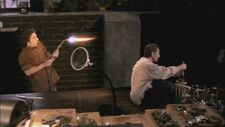
These fairies are dangerously homicidal and are known for mercilessly killing travelers who trespass their territory. Their hats are red because they soak them in the blood of their victims, and, according to lore, redcaps have to kill regularly because if the blood dries on their hats they will die. The one seen in the episode displayed enhanced strength and the ability to teleport.

According to Wayne Whittaker the leprechaun, there is a fairy devil. Its name, gender, and the powers it possesses are unknown.
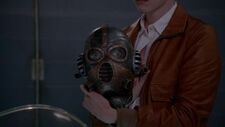
It is implied that other types of fairies include sprites, spriggans, boggarts, brownies, gnomes, and goblins. Additionally, creatures from Oz could also be considered to be fairies, such as flying monkeys.
Powers and Abilities
Fairies' powers, as they're known to come in "different shapes and sizes", are dependent on the fairy at hand, as certain types hold separate, individual powers.
- Magic - Fairies are incredibly powerful magical beings, being apparently "all about energy."
- Spell Casting - Leprechauns have been shown to make deals, like crossroads demons, to cast spells.
- Invisibility - They can only be seen if they want to be or by people who have traveled to their realm and returned. This ability continues to work, even after the fairy in question's death, meaning humans who haven't been to the fairy realm can't see their remains.
- Photokinesis- Being beings made of energy, most fairies are able to control and manipulate light.
- Telekinesis - Some fairies, such as leprechauns, can move objects with their minds.
- Teleportation - Some fairies, such as leprechauns, can teleport from any location to another in the blink of an eye. Good fairies can take people with them.
- Apporting - Good fairies can teleport people to places, as with Gilda where she able to send Gerry to Avalon.
- Soul Reading - A leprechaun showed the ability to tell if a person has a soul or not, just by looking at them.[1]
- Immortality - Fairies are immortal beings.
- Super Strength - The strength of a fairy depends on the type of fairy. Leprechauns can launch humans across rooms with their bare hands easily, tinks can knock humans around by ramming into them, and redcaps and the Wicked Witch can throw humans around.
- Flight - Tinks can fly.
- Reality Warping - Powerful fairies, such as Gilda, and leprechauns can manipulate reality, doing things such as manipulating space to imprison a person or making a person mimic death, with no actual stimulus (much like hex bags). The fairy being known as the Wicked Witch was able to transform three freedom fighters into a tin man, a scarecrow, and a cowardly lion. Also, Gilda was able to transform a fake-sword into a real sword and two guns into feathers.
It is speculated that they all have a number of common abilities within them, like magical knowledge (being able to cast magic thanks to their knowledge and nature), invisibility (as they can hide from humans who have not been to the Fairy Realm), enhanced strength, possibly immortality, and telekinesis (the ability to move objects with their minds). However, special abilities could also be limited to some kind of fairies, like flying (as tinks have wings).
Weaknesses
As with many other supernatural creatures, fairies have weaknesses that can be used to defeat them. However, none of these methods were proven to be able to completely kill them; the only way to stop them is banishing them to their realm through a spell. However the above isn't completely true: if a fairy is exposed to a very strong electromagnetic field for enough time they will lose control of themselves and explode, as Dean was able to kill one by trapping the fairy into a microwave oven, however as the fairy in question was very weak, its unknown what affect it would have on a more powerful fairy.
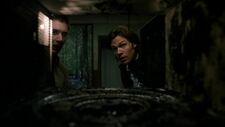
- Iron - Fairies hate iron as it is proven to be harmful against them (even though it does not necessarily kill them).
- Silver - It can cause dark fairies pain and can kill them
- Items that have Multiple Grains - If someone pours any substance that has a lot of grains in front of them, they have to stop to count each grain one by one. They remain fully aware while doing so, and are very reluctant about that weakness.
- Salt - Used against a Leprechaun, Wayne Whittaker.
- Cream - They also love cream, which, like alcohol, intoxicates them.
- Magic - Fairies can be summoned, bound and banished by magic, once banished they are unable to return unless summoned again.
Type-Specific Weaknesses
In addition to the common weaknesses of all fairies, certain types of fairies also have additional weaknesses.
Changelings
- Fire - Setting a changeling on fire will cause its body to rapidly burn to ashes.
- Family - Killing a mother changeling will cause its children to die instantly.
- Mirrors - A changeling's true form is revealed in a mirror.
Tinks
- Radiation - Due to their small size, Tinks are particularly susceptible to microwave radiation; direct exposure for a sufficient amount of time will make them explode.
The Wicked Witch
- Poppy Extract - The Wicked Witch could be harmed by poppy extract.
- Ruby Slippers - The Wicked Witch could be killed by the Ruby Slippers.
- Devil's Trap - The traps and protective enchantments of the Men of Letters were so powerful, they could deter even the Wicked Witch.[2]
Known Fairies
- Changelings
- Elves
- Fairy Banshees
- Flying Monkeys
- Leprechauns
- Redcaps
- Tinks
- Tooth Fairies
- Tooth Fairy (Southern Comfort)
- Tooth Fairy Conjuration
- Fairy Devil
- Gilda
- Oberon
- The Wicked Witch
- Tin Man
- The Scarecrow
- Cowardly Lion
- Fairy Godmothers
- Gnomes
Lore
In Western European folklore, a fairy is a type of mythical being or legendary creature, a form of spirit, whose habitats are woodlands and gardens. Fairies resemble various beings of other mythologies, though even folklore that uses the term fairy offers many definitions. Sometimes the term describes any magical creature, including goblins or gnomes; at other times, the term only describes a specific type of more ethereal creature.
In the original legends about fairies, they were human-sized or nearly so, their small sizes were the results of shapeshifting. However in the Victorian-era children's literature and art revealed a fascination with these supernatural beings, and it mutated them to a considerable extent. Beginning with Perrault and the Brothers Grimm, there was an emerging - and increasingly popular - trend to collect the adult folk literature of the folktale and transform it into printed, abridged "fairytales" for the consumption of urban children of the emerging middle class.
For Victorian children's literature, this dangerous aspect of the supernatural beings needed to be diminished, and the supernatural beings needed to be reduced in other ways. Beginning with the publications of Ann Elizabeth Bray in 1838, dealing with Cornish and Devonian Pixies, Victorian literature found a key in diminishing the frightful aspect of the supernatural beings. While the folk in many places conceived of their supernatural beings as capable of small stature (i.e shapeshifting), here was a body of folklore that made it the standard for these entities.
Appearances
- Season 1
- Scarecrow (The Scarecrow, referenced only)
- Season 3
- The Kids Are Alright (Changelings)
- Fresh Blood (Tooth Fairies, mentioned only)
- Season 4
- Are You There, God? It's Me, Dean Winchester (fairy dust, mentioned only)
- It's the Great Pumpkin, Sam Winchester (Leprechaun, mentioned only)
- Season 5
- Season 6
- Clap Your Hands If You Believe (Leprechauns, Tinks, Elves and Redcaps; Oberon and Rumplestiltskin, mentioned only)
- Season 7
- Plucky Pennywhistle's Magical Menagerie (Leprechaun, mentioned only)
- Season 8
- Southern Comfort (Tooth Fairy, mentioned only)
- LARP and the Real Girl (Gilda)
- Season 9
- Slumber Party (The Wicked Witch and Flying Monkeys; The Tin Man and Scarecrow, mentioned only)
- The Purge (Changelings, mentioned only)
- Meta Fiction (fairy bones, mentioned only)
- Season 10
- Black (Tin Man, mentioned only)
- The Hunter Games (Titania, mentioned by Rowena in a spell)
- Season 11
- Thin Lizzie (Cowardly Lion, referenced only)
- Into the Mystic (Benevolent Banshees, mentioned only)
- Season 15
- The Heroes' Journey (Tooth Fairy, mentioned only)
- Supernatural: The Men of Letters Bestiary: Winchester Family Edition (non-canon, mentioned only)
Trivia
- The book Supernatural: The Official Companion Season 3, indicates that changelings can be any sort of magical creature, ranging from selkies (creatures that looks like seals, but can shed their skin to look human) to fairies, elves and trolls which are more common. "In the lore they're not called 'changeling parents', Sera Gamble explains. They're goblins and fairies and trolls, but we don't talk about fairies very much on Supernatural... except disparagingly when somebody talks about a creature that Dean is sure doesn't exist. He's like 'Yeah, fairies and unicorns..". Furthermore the book Supernatural: The Official Companion Season 6, indicates that changelings are in fact a type of fairy rather than a monster.
- In traditional folklore, the fairy queen has no name. However, she became known as Titania due to William Shakespeare's play A Midsummer Night's Dream in which the Queen is having relationship issues with her husband Oberon. Shakespeare took the name "Titania" from Ovid's Metamorphoses, where it is an appellation given to the daughters of Titans.
- Wayne Whittaker believed that fairies are much stronger than angels and have "a real magic."
- It's unclear where fairies go when they die or get killed, if they go to an after life in Avalon, an unknown realm, to the Empty or if dead fairies have any after life.


